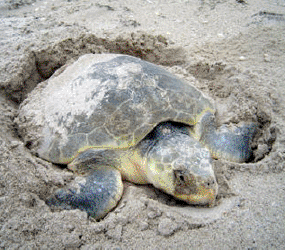
NPS Photo Currently the NPS removes all sea turtle eggs that are located from the beach and transfers them to the incubation facility at PAIS. Hatching success is usually elevated substantially for eggs that are transferred to this facility rather than left on the beach to hatch. The NPS also protects nesting turtles while they are on the beach and removes stranded turtles for rehabilitation or study.As a beneficial side effect, trained observers and oil and gas vehicle operators provide additional observations and assist the NPS with its efforts to detect, investigate, monitor, and protect nesting sea turtles, nests, hatchlings, and stranded turtles. To reduce the direct impacts that could occur from crushing or covering of nests or turtles, many mitigation measures have been created and are applied to all oil and gas operators. These measures include:· Having all drivers of oil and gas equipment attend a sea turtle awareness training class held by the NPS.· Convoying all large trucks during the sea turtle nesting season.· Having an NPS patroller conduct a morning patrol before large vehicles can traverse the beach.· Establishing a “Protected Season” to provide additional protection to Kemp’s ridleys sea turtles, nests, and hatchlings during the peak nesting season.There has been vehicle traffic, from both visitors and heavy equipment operators, on the Gulf of America shoreline for over fifty years with no documented case of a crushing of a nesting sea turtle within the park.
|
Last updated: February 18, 2025
